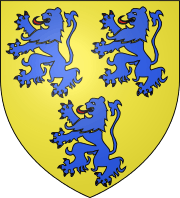Viscounty of Limoges
Between Limoges, Brive and Périgueux, the viscounts of Limoges, also called viscounts of Ségur created a small principality, whose last heir was Henry IV. Ségur was the main home of these viscounts, in the heart of their domain. The viscounty went from the Limoges-Ségur family to the House of Montfort in Brittany, then to the Albrets and eventually to the Bourbons.

Territory
Their territory included the castles of Ségur, Excideuil, Aixe-su-Vienne, Auberoche and Nontron.

Ségur Castle
Built in a shingle of the Auvézère River, at the borders of Saint-Eloi, Saint Julien, Payzac and Beyssenac parishes, the place is naturally defensive. The Ségur "verteil" (headquarters of the milites castri, the knights who defend the castle) was home to the Pérusse family (future dukes of the Cars), Bonneval family (future marquises of Bonneval) (Claude Alexandre de Bonneval became a famous Ottoman Empire pasha), and Prévot family (later "du Mas" family, future marquises of Paysac).
The upper castle is in ruins. Today, the only remaining part is the Pérusse hotel, in the "verteil". No visits (December 2006)
Excideuil Castle
Only two large towers remain, joined together by a screen wall that used to be the aula pinion. The main home (16th or 17th century?) was doubled in width at the beginning of the 20th century. The outward gate of the milites castri's verteil is a Renaissance door.
Aixe Castle
A merovingian castrum was recorded as being at the confluence of the river. The Château d'Aixe (or "Tour Jeanne d'Albret") was constructed in the 13th century in Aixe-sur-Vienne, controlled by the viscounts of Limoges. It was demolished at the beginning of the 19th century.
Thiviers Castle
Auberoche Castle
See Château d'Auberoche in the French Wikipedia for a detailed discussion (in French).
Probably around 1037 or 1059, the successor of Bishop Frotaire (the castrum founder) is said to have submitted the place to the Limoges viscount, in order to get the protection of this laic potentate against the Count of Périgord.
As soon as the last third of the 12th century (1154–1157), the Viscount of Limoges acknowledged the bishop of Périgueux as his suzerain, as far as Auberoche is concerned. By this submission, the viscount extended his domination up to the Périgord episcopal and county headquarters gates. Therefore, the viscounts of Limoges could maintain and use their political and economic power at the gates of Périgueux. The castle became a chaplain center which included 16 parishes (in 1365) and controlled two main, convergent traffic streams towards Périgueux city, through the Auvézère and Manoir valleys.
Confirmed as soon as September 1257, the judicial and administrative power was enforced in the whole district area by a provost, the agent of the viscount of Limoges.
All location castles came under the ownership of the Segur viscounts who were initially abbots or clergy. The Monsbruen-Segur line came to be known as the barons that would fuel both the French and Provençal Kingdoms but also the dominators of the Anglo-Saxon Kingdoms throughout Briton, Celtic and Norse lands by intermarriage with the Anglo-Saxon Kings like the predecessors the Britons who were a united branch of exiled Greek warriors and criminals who escaped the Turkish domination of the Achaea region of Greece and Rome's only influence were churches and statesmen in Brittania.